

|
Home Updates Hydros Cars Engines Contacts Links Contact On The Wire |
Model Accessories Supply Co
In the immediate post war period a large number of companies were set up supplying models and parts for the rapidly expanding tethered car market, along with a host of other model related items. Douglas Russell was well to the fore in this, having as editor of Aeromodeller been one of the prime movers in establishing the interest in tethered cars during WW2. With his associated businesses in publishing and the Eaton Bray Sportsdrome he further diversified by setting up the Model Accessories Supply Co (MASCO) late in 1947. The companies address was initially given as Gray's Inn Road W.C.1 but this soon reverted to the Sportsdrome address at Billington.
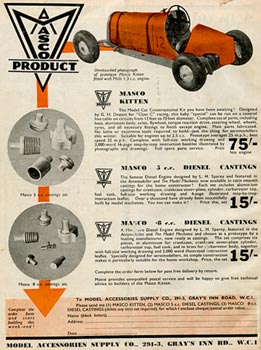 |
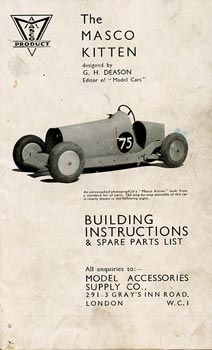 |
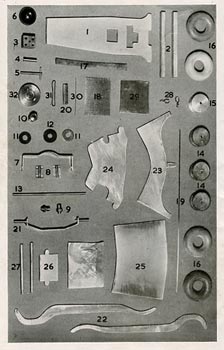 |
| MASCO ad, Kitten and Diesel castings | Kitten Construction booklet | Early Kitten kit |
One of the earliest products that the company advertised was Geoffrey Deason’s design of a 'C Class' model race car. The MASCO ‘Kitten’ was introduced to the public via a four page article in Model Cars in September 1947. Marketed as a ‘kitchen table special’ because it needed only the most basic tools to construct, and built round the reliable and popular Mills 1.3cc diesel engine, it was very much aimed at beginners. Douglas Russell's son Tim recalls spending a fair proportion of his school holidays operating a power saw and lathe making flywheels for the ‘Kitten’. It was shortly after the Kitten was announced that the MASCO company appeared, marketing kits for the car, complete with a plan and booklet detailing the construction and how to run it when completed. The cost for the kit initially was 75 shillings, but in 1949 was reduced to 49/6d. Easy payments were also offered, for the Kitten, a deposit of 14 shillings was required, with five monthly payments of 10 shillings, and a final payment of 11 shillings, way ahead of its time in offering interest free loans.
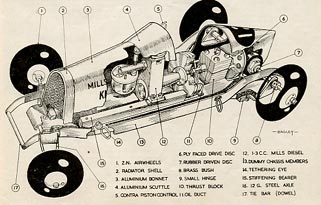 |
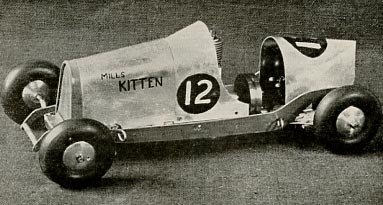 |
| Early Bagley drawing of the Kitten | Kitten prototype with exposed motor |
The car could hardly have been more simple as no castings at all were used, the chassis was plywood with friction drive to the rear axle, hinged on another piece of plywood. Axle mounts were bent strip steel with the drive shaft being held in place by two bits of hardwood screwed to the chassis. The original plan specified ZN Airwheels although the early kits had a selection of tyres including some that were from very soft white or brown sponge rubber. Later these were changed to black Sorbo rubber with ribbed treads, a change noted in the adverts. The body was formed by rolling sheet aluminium round suitable formers and was very much in the style of early cyclecars. A handy template for the body was published for those that built from scratch, but disaster beckoned if this was followed as it did not match the new body shape. Self publicity was never far away from the activities of Russell and soon there were references to over 2,000 kits having been sold all round the world.
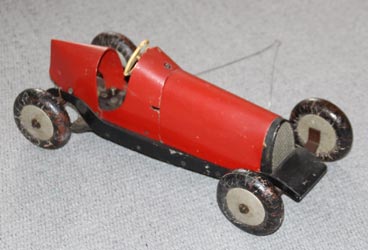 |
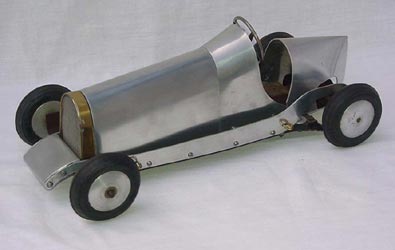 |
| Original, first version with white, sponge, tyres | Later version with ribbed tyres |
Adverts from the Company soon listed a range of other products, which include a saw bench, either complete or as castings, as well as castings for a dividing head, all again available for outright purchase or with easy payments. The company also offered complete Kitten cars to any dealers taking on six kits? In 1948 there were the headlines 'New! Sensational! Die Castings For Amateur Diesel Makers' featuring the ‘Buzzard’ 2.8cc diesel engine, for which the die-castings could be purchased. Described as a ‘new design by best-known diesel experts DAR and LH Sparey’, it too could be bought on similar easy payment terms. Previous to this an article on diesel engines by Lawrence Sparey with the foreword by DAR had appeared in Dec 45 issue of the Aeromodeller. DAR wrote, “my own experience of internal combustion engines ranges over the past 25 years. Shortly after the last war (WW1) I was engaged on the manufacture of ‘diesel’, semi diesel, ’hot-bulb’ and the normal type of petrol engines of capacities of from a few horsepower up to as much as fifty horsepower per cylinder. And in that period there have been innumerable improvements, alterations, additions, (not to mention subtractions!) attributable to many men. Who invented the model diesel engine? I can only say, I do not know, certainly we did not. But we were the first in this country to carry out over the past three or four years, considerable research and development work. This, however, does at least enable us to publish the first authoritative survey on this type of engine, based on our own practical work.”
In 1949, apart from announcing the reduction in the price of the Kitten, the range of parts for tethered cars had increased with castings available for the 'Dowson Lightweight' from Jack Gascoigne's original patterns at 25/- for the pan, eight of the complex wheel halves and a working drawing. In an attempt to plug into the Jetex market MASCO introduced the "Jetmobile", modelled on a Frazer Nash sports car and advertised to reach speeds of 'up to 40mph with a Jetex 350'. The complete kit was post free at 17/6. As far as is known, none of these has ever been positively identified, although Kittens are relatively common, hardly surprising if the number sold is anything like accurate. Genuine versions of any of the MASCO motors are exceedingly rare though, but thanks to John Goodall, for adding these details and photos of the Buzzard.
Masco Buzzard 2.8cc diesel engine.
Two of the pioneers of model engine movement in this country were the famous Edgar T. Westbury and Laurence H. Sparey both promoting model engine design through home construction articles in the model engineering press. Westbury publishing a regular feature on design and construction in Model Engineer throughout the pre WW2 years. Sparey became better known in the years after WW2 when he initially became co-editor of Model Maker with G.H. Deason who had previously been editor of of Model Cars. This did not last long as Sparey soon became well known for his engine reviews in Aeromodeller magazine complete with three view drawings which were very useful to modellers intending to use the review engine in a model. The period he covered was between 1948 and 1952 when Ron Waring took over the engine test and reviews.
|
One of Sparey’s first designs was the 5cc sideport diesel which first appeared in Aeromodeller in May 1946 the plan costing 3 shillings and six pence. The book Model Diesels also published the same design said to be by the Aeromodeller Research Staff and Harborough Publications. It was later widely understood to be a Sparey design. Castings for the engine were provided by Masco and also for the smaller of his designs which was published wrongly as The 0.80cc sideport compression ignition engine, more correctly it was just over 0.63 cc. It seems a link was established between Masco and Sparey leading to the Masco 2.8cc design which is very similar but smaller than the Aeromodeller 5cc engine, the lineage being very evident. The Masco intention was to make it available as a kit for home construction to extend the range and complement their other model products. Both the drawing and box interestingly announce the design as being a joint effort of D.A. Russell and L.H. Sparey. The Kit cost 21 shillings with all the material needed included to build the engine. |
|
Turning to the engine it is a nicely designed and well thought out side port motor, with neatly produced die cast castings for the crank case, cylinder and carburettor assembly. The transfer passage is cast into the front of the cylinder and with exhaust stubs neatly cast into each side of the cylinder. It has a long stroke like its siblings and it measure 13mm bore and 20mm stroke, so a steady, easy starting plodder. It is a heavy engine and I suspect the crank case casting maybe Mazak a die casting zinc alloy, it looks to me like it is. (Confirmed by MASCO adverts) John Goodall
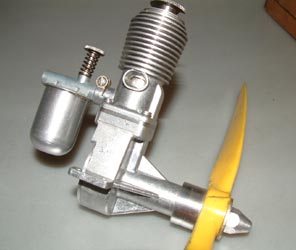 |
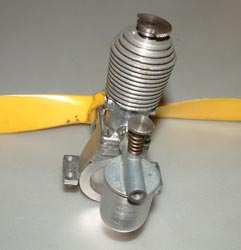 |
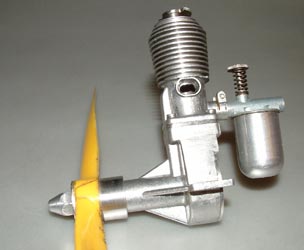 |
| MASCO Buzzard, combination of Mazak and aluminium castings that 'needed no further work on the finish' | ||
As detailed in our earlier article on Eaton Bray and Douglas Russell, an expensive prosecution, products that were probably outdated almost as soon as they had been announced, a rapidly changing market and the increasing availability of more, far better engineered cars and more powerful engines saw the rapid demise of all of the companies associated with Russell, including MASCO and the Sportsdrome, which closed in 1951.
©copyrightOTW/JohnGoodall2022